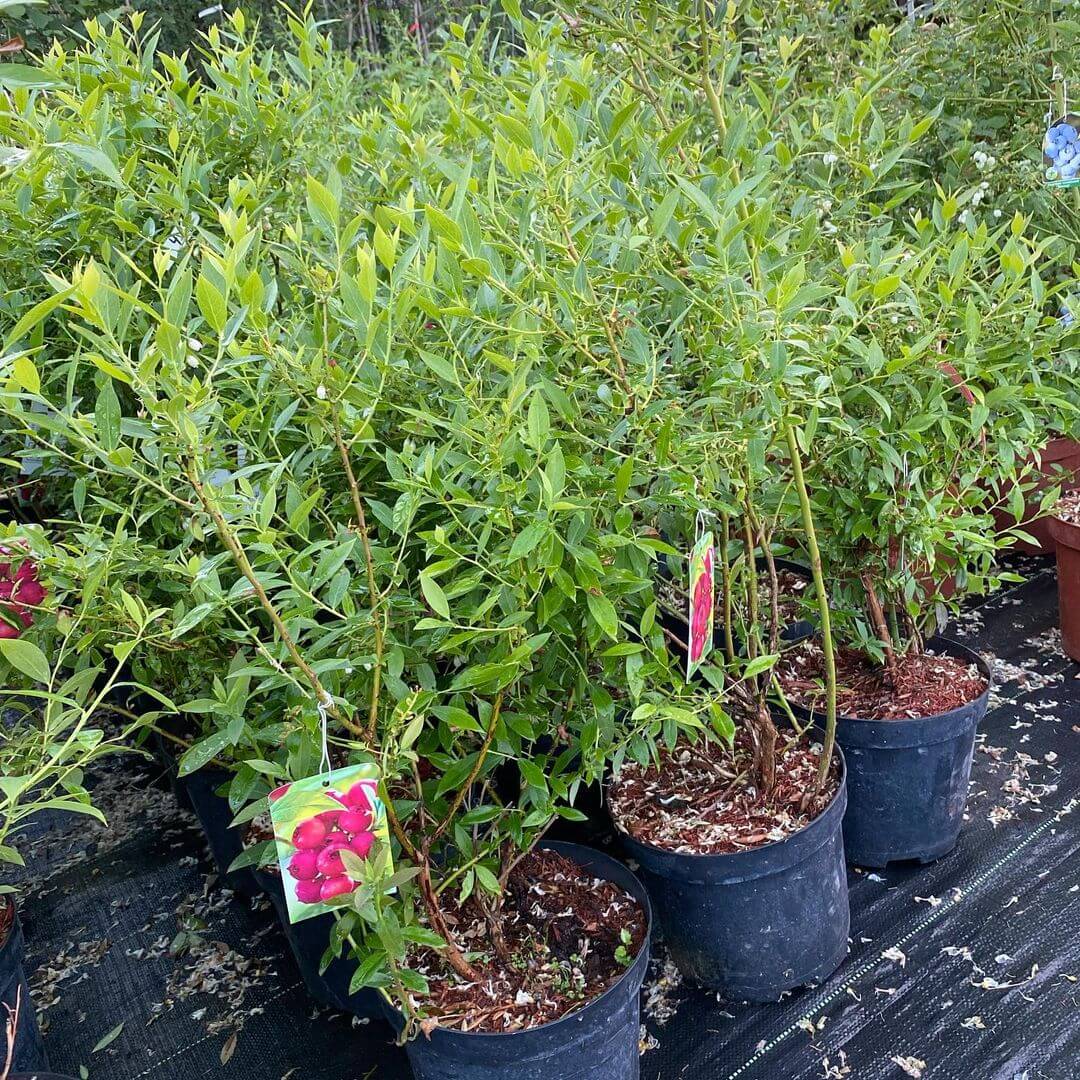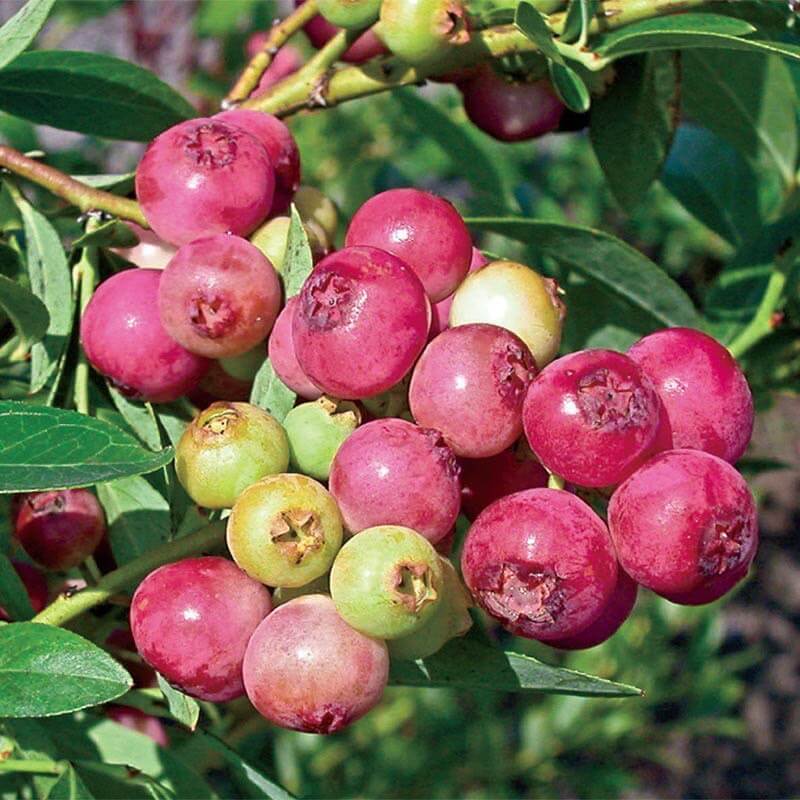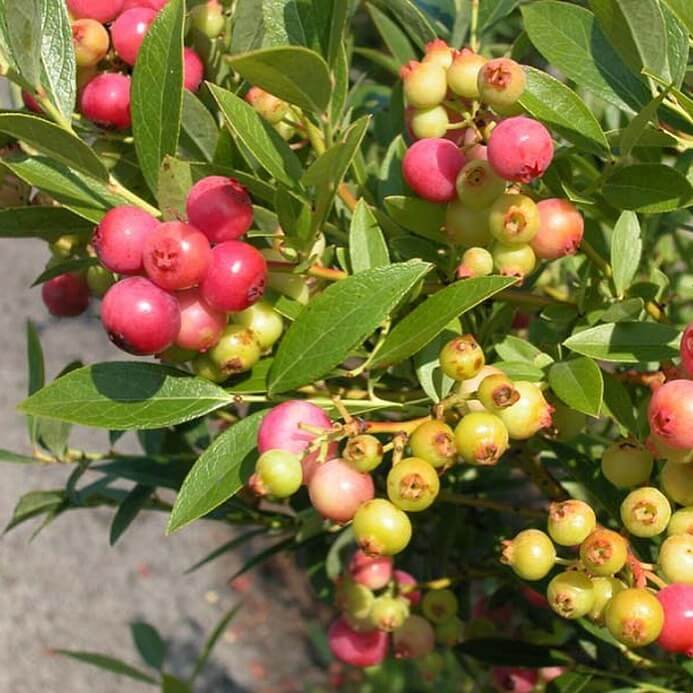Pink Lemonade blueberry shrubs are a relatively new variety of blueberries that have become quite popular amongst homeowners and landscapers in recent years. As their name suggests, they produce bright pink lemonade-flavored berries that are simply delicious eaten fresh, or used in various recipes.
These compact shrubs are native to North America and are easy to grow in most regions with adequate sunlight and acidic soil. With proper care, they will reward you with abundant sweet berry harvests for many years. Their pretty pink flowers and foliage also make them an attractive ornamental plant.
The Pink Lemonade cultivar was specially bred by researchers to have superior fruit qualities compared to older Southern Highbush varieties. It is a patented variety protected under the US Plant Patent system.
| Botanical Name | Vaccinium corymbosum ‘Pink Lemonade’ |
| Plant Family | Ericaceae |
| Common Varieties | Pink Popcorn, Pink Icing |
| Plant Type | Deciduous shrub |
| Mature Size | 4-5 feet high and wide |
| Growth Habit | Upright and compact, vase-shaped form |
| Foliage | Green oval leaves turn vibrant red in fall |
| Sunlight | Full sun (at least 6 hours daily) |
| Soil | Moist, acidic, well-draining soil with pH of 4.5-5.5 |
| USDA Zones | 5-8 |
| Exposure | Sheltered spot protected from wind |
Being a dwarf variety, Pink Lemonade blueberry plants grow to a manageable size of about 4-5 feet tall and wide at maturity. This makes them well-suited for planting in containers and smaller backyard gardens.
They have an upright, vase-like growth habit with branches that arch gracefully under the weight of the ripening berry clusters. The green oval-shaped leaves turn into stunning shades of red and orange in the fall, allowing the shrubs to provide year-round visual interest.
Planting Pink Lemonade Blueberry


The best times for putting Pink Lemonade blueberry shrubs in the ground are early spring and fall. This gives the plants enough time to establish themselves before the heat of summer or the cold of winter sets in.
- When planting, dig a hole that is twice as wide as the nursery container and deep enough to accommodate the root ball.
- Carefully remove the plant from its container, loosen the circled roots, and place it in the planting hole at the same depth it was originally growing at.
- Backfill with native soil, tamp down gently and water thoroughly to settle the roots.
- Spread a 2-4 inch thick ring of mulch around the base to help retain moisture and suppress weeds.
Pink Lemonade Blueberry Plant Care

Light
Pink Lemonade blueberry bushes require full sun exposure to thrive. Insufficient sunlight will result in reduced flowering and fruit production. Choose a spot that receives direct sunlight for most of the day. Light afternoon shade is okay but avoid planting in heavily shaded areas.
Soil
Like all blueberries, Pink Lemonade needs acidic soil with a pH between 4.5 and 5.5. Anything higher will prevent the plants from absorbing nutrients efficiently. Test the soil pH before planting and amend with sulfur if needed to lower the pH.
The soil itself should be loose, fertile, and drain freely without waterlogging. Incorporate generous amounts of compost or peat moss when preparing the planting beds. Container-grown plants need a quality potting mix formulated for acid-loving plants.
Temperature and Humidity
The plants grow best in climates with cool nights and warm days during the growing season. Shelter them from harsh winter cold and late spring frosts which can damage the flower buds and affect the harvest.
You can maintain optimal humidity around the bushes by regularly misting the leaves or using drip irrigation.
Water
Pink Lemonade blueberry plants are native to areas with humid climates and cannot tolerate dry soil conditions. Make sure to water them regularly with about 1-2 inches of water per week by rainfall or supplemental irrigation.
The shallow root system appreciates a thick layer of organic mulch around the base to maintain optimal moisture and temperature levels. Drought stress can cause permanent damage to the productivity of the bushes.
Fertilizer
Getting the fertilization right is crucial when caring for Pink Lemonade shrubs. Only use acidic plant foods tailored for blueberries and apply them in the early spring and after harvest.
Good organic options include fish emulsion and cottonseed meal which help acidify the soil. Excess nitrogen can burn the sensitive roots and should be avoided.
Pruning
Pruning the shrubs every year helps stimulate new growth and allows for better light exposure and air movement within the plant canopy. It prevents overcrowding and removes older canes that have finished fruiting. Follow-up with a balanced fertilizer application after pruning.
Harvesting Your Pink Lemonade Blueberry


The pretty pinkish-red berries start ripening in early summer and are ready for picking from mid to late summer in most regions, depending on the climate and cultivar. Time your harvests so that the berries are sweet, firm, and fully colored. Pick the ripe fruit clusters every 3-4 days with the stems attached. Refrigerate promptly and use within 5-10 days for best quality.
The sweet lemonade-flavored berries are simply delicious when eaten fresh or used as colorful additions to muffins, pies, jam, yogurt parfaits, and countless other recipes. Kids and adults alike will enjoy snacking on the harvest straight from the bush!
Propagating Pink Lemonade Blueberry
Pink Lemonade blueberries breed true from seed hence seed propagation is a viable option. However, plants grown from cuttings maintain the same traits as the parent.
- Cuttings – Take 6-inch semi-hardwood cuttings in late summer. Dip in rooting hormone then stick into moist propagating mix. Maintain warmth and high humidity until well-rooted.
- Layering – Bend low-growing stems to ground level and bury a few inches below soil, leaving the last 6-8 inches above ground. New roots form at the buried section while the tip continues growing.
- Division – Mature plants can be divided by uprooting and splitting multi-stemmed bushes into smaller sections. Replant immediately.
Common Pests, Diseases, and Animal Intruders
Birds love feasting on the sweet berries as much as we do and may leave you with none if you do not take protective measures! Install bird nettings over your bushes as the fruits start coloring up.
Aphids, mummyberry fungus, cankers, and midges can also attack the plant but can generally be managed by maintaining optimal growing conditions and promptly removing and destroying severely infected plant parts.
Landscaping Uses and Companion Planting
The compact size and multi-season appeal of Pink Lemonade blueberry bushes makes them ideal choices for inclusion in edible ornamental gardens and mixed borders. Here are some tips:
- Use as striking feature plants in herb and vegetable gardens.
- Underplant them with daffodils, azaleas, and heathers.
- Allow some fallen leaves around the base to acidify the soil.
- Plant next to roses, lavender, and sage for great combinations.
- Grow in containers on patios and decks.
Pink Lemonade blueberry shrubs serve both ornamental and edible purposes very well. With proper care, they will keep rewarding you with their sweet harvests and charm for years to come.
FAQs
The pink lemonade blueberry is a hybrid variety that was bred from a cross between a rabbiteye blueberry and a highbush blueberry. Specifically, it has genetics from both rabbiteye and southern highbush blueberry varieties.
Yes, pink lemonade blueberry is a hybrid variety resulting from intentional cross-breeding of different blueberry species.
Pink lemonade blueberries likely have similar health benefits as regular blueberries, which are known to be high in antioxidants that can help reduce inflammation, lower blood pressure, and promote heart health.
The most common types of blueberry bushes are northern highbush (hardy in zones 4-7), southern highbush (zones 7-10), and rabbiteye (zones 5-9). Rabbiteye blueberries are popular across most regions.
